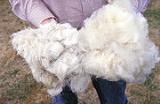
Wool
Encyclopedia
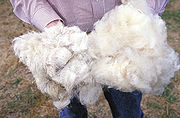
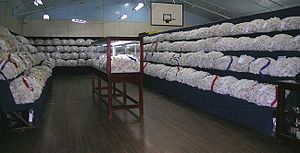
Textile
A textile or cloth is a flexible woven material consisting of a network of natural or artificial fibres often referred to as thread or yarn. Yarn is produced by spinning raw fibres of wool, flax, cotton, or other material to produce long strands...
fiber
Fiber
Fiber is a class of materials that are continuous filaments or are in discrete elongated pieces, similar to lengths of thread.They are very important in the biology of both plants and animals, for holding tissues together....
obtained from sheep
Domestic sheep
Sheep are quadrupedal, ruminant mammals typically kept as livestock. Like all ruminants, sheep are members of the order Artiodactyla, the even-toed ungulates. Although the name "sheep" applies to many species in the genus Ovis, in everyday usage it almost always refers to Ovis aries...
and certain other animals, including cashmere
Cashmere wool
Cashmere wool, usually simply known as cashmere, is a fiber obtained from Cashmere and other types of goats. The word cashmere derives from an old spelling of Kashmir. Cashmere is fine in texture, and strong, light, and soft. Garments made from it provide excellent...
from goats
Cashmere goat
A cashmere goat is any breed of goat that produces cashmere wool, the goat's fine soft downy winter undercoat, in commercial quality and quantity. This undercoat grows as the day length shortens and is associated with an outer coat of coarse hair, which is present all the year and is called guard...
, mohair
Mohair
Mohair usually refers to a silk-like fabric or yarn made from the hair of the Angora goat. The word "mohair" was adopted into English before 1570 from the Arabic: mukhayyar, a type of haircloth, literally 'choice', from khayyara, 'he chose'. Mohair fiber is approximately 25-45 microns in...
from goats, qiviut
Qiviut
Qiviut is an Inuit word commonly used to indicate the wool of the muskox. The word was originally used to refer to the down feathers of birds as well as the inner wool of the muskox. It is valued for its use as a fiber as, unlike sheep's wool, it does not shrink in water at any temperature...
from muskoxen, vicuña
Vicuña
The vicuña or vicugna is one of two wild South American camelids, along with the guanaco, which live in the high alpine areas of the Andes. It is a relative of the llama, and is now believed to share a wild ancestor with domesticated alpacas, which are raised for their fibre...
, alpaca
Alpaca
An alpaca is a domesticated species of South American camelid. It resembles a small llama in appearance.Alpacas are kept in herds that graze on the level heights of the Andes of southern Peru, northern Bolivia, Ecuador, and northern Chile at an altitude of to above sea level, throughout the year...
, camel
Camel
A camel is an even-toed ungulate within the genus Camelus, bearing distinctive fatty deposits known as humps on its back. There are two species of camels: the dromedary or Arabian camel has a single hump, and the bactrian has two humps. Dromedaries are native to the dry desert areas of West Asia,...
from animals in the camel family, and angora
Angora wool
Angora wool or Angora fibre refers to the downy coat produced by the Angora rabbit. While their names are similar, Angora fibre is distinct from mohair, which comes from the Angora goat. Angora is known for its softness, thin fibres, and what knitters refer to as a halo...
from rabbits
Angora rabbit
The Angora rabbit is a variety of domestic rabbit bred for its long, soft wool. The Angora is one of the oldest types of domestic rabbit, originating in Ankara , Turkey, along with the Angora cat and Angora goat. The rabbits were popular pets with French royalty in the mid 18th century, and spread...
.
Wool has several qualities that distinguish it from hair or fur: it is crimped, it is elastic
Elasticity (physics)
In physics, elasticity is the physical property of a material that returns to its original shape after the stress that made it deform or distort is removed. The relative amount of deformation is called the strain....
, and it grows in staples (clusters). The term wool is usually restricted to describing the fibrous protein
Protein
Proteins are biochemical compounds consisting of one or more polypeptides typically folded into a globular or fibrous form, facilitating a biological function. A polypeptide is a single linear polymer chain of amino acids bonded together by peptide bonds between the carboxyl and amino groups of...
derived from the specialized skin
Skin
-Dermis:The dermis is the layer of skin beneath the epidermis that consists of connective tissue and cushions the body from stress and strain. The dermis is tightly connected to the epidermis by a basement membrane. It also harbors many Mechanoreceptors that provide the sense of touch and heat...
cells called follicles
Hair follicle
A hair follicle is a skin organ that produces hair. Hair production occurs in phases, including a growth phase , and cessation phase , and a rest phase . Stem cells are principally responsible for the production of hair....
in sheep.
Characteristics


Spinning (textiles)
Spinning is a major industry. It is part of the textile manufacturing process where three types of fibre are converted into yarn, then fabric, then textiles. The textiles are then fabricated into clothes or other artifacts. There are three industrial processes available to spin yarn, and a...
the fleece by helping the individual fibers attach to each other, so that they stay together. Because of the crimp, wool fabrics have a greater bulk than other textiles, and retain air, which causes the product to retain heat. Insulation also works both ways; Bedouin
Bedouin
The Bedouin are a part of a predominantly desert-dwelling Arab ethnic group traditionally divided into tribes or clans, known in Arabic as ..-Etymology:...
s and Tuaregs use wool clothes to keep heat out.
The amount of crimp corresponds to the fineness of the wool fibers. A fine wool like Merino
Merino
The Merino is an economically influential breed of sheep prized for its wool. Merinos are regarded as having some of the finest and softest wool of any sheep...
may have up to 100 crimps per inch, while the coarser wools like karakul may have as few as 1 to 2. Hair, by contrast, has little if any scale and no crimp, and little ability to bind into yarn. On sheep, the hair part of the fleece is called kemp
Kemp (wool)
Kemp is generally a chalky-white, brittle, weak fibre which may be mixed with normal fibers in a sheep's wool fleece. Kemp fibres are often detached from the skin. This hair is not desirable in a fleece, as it does not accept dye, minimising both the quality and the value of the wool....
. The relative amounts of kemp to wool vary from breed to breed, and make some fleeces more desirable for spinning
Spinning (textiles)
Spinning is a major industry. It is part of the textile manufacturing process where three types of fibre are converted into yarn, then fabric, then textiles. The textiles are then fabricated into clothes or other artifacts. There are three industrial processes available to spin yarn, and a...
, felting, or carding
Carding
Carding is a mechanical process that breaks up locks and unorganised clumps of fibre and then aligns the individual fibres so that they are more or less parallel with each other. The word is derived from the Latin carduus meaning teasel, as dried vegetable teasels were first used to comb the raw wool...
into batt
Batting (material)
Batting is a layer of insulation used in quilting between a top layer of patchwork and a bottom layer of backing material. Batting is usually made of cotton, polyester, and/or wool....
s for quilts or other insulating products including the famous Tweed (cloth)
Tweed (cloth)
Tweed is a rough, unfinished woolen fabric, of a soft, open, flexible texture, resembling cheviot or homespun, but more closely woven. It is made in either plain or twill weave and may have a check or herringbone pattern...
cloth of Scotland.
Wool fibers are hydrophilic, meaning they readily absorb moisture. Wool fibers are hollow. Wool can absorb moisture almost one-third of its own weight.
Wool absorbs sound like many other fabrics. Wool is generally a creamy white color, although some breeds of sheep produce natural colors such as black, brown, silver, and random mixes.
Wool ignites at a higher temperature than cotton
Cotton
Cotton is a soft, fluffy staple fiber that grows in a boll, or protective capsule, around the seeds of cotton plants of the genus Gossypium. The fiber is almost pure cellulose. The botanical purpose of cotton fiber is to aid in seed dispersal....
and some synthetic fibers. It has lower rate of flame spread
Flame spread
Flame spread or surface burning characteristics rating is a ranking derived by laboratory standard test methodology of a material's propensity to burn rapidly and spread flames...
, low heat release, low heat of combustion, and does not melt or drip; it forms a char which is insulating and self-extinguishing, and contributes less to toxic gases and smoke than other flooring products, when used in carpets. Wool carpets are specified for high safety environments, such as trains and aircraft. Wool is usually specified for garments for fire-fighters, soldiers, and others in occupations where they are exposed to the likelihood of fire.
Wool is resistant to static electricity
Static electricity
Static electricity refers to the build-up of electric charge on the surface of objects. The static charges remain on an object until they either bleed off to ground or are quickly neutralized by a discharge. Static electricity can be contrasted with current electricity, which can be delivered...
, as the moisture retained within the fabric conducts electricity. This is why wool garments are much less likely to spark or cling to the body. The use of wool car seat covers or carpets reduces the risk of a shock when a person touches a grounded object. Wool is considered by the medical profession to be hypoallergenic.
Shearing
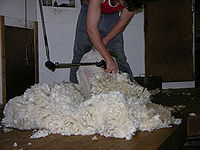
Sheep shearing
Sheep shearing
Sheep shearing, shearing or clipping is the process by which the woollen fleece of a sheep is cut off. The person who removes the sheep's wool is called a shearer. Typically each adult sheep is shorn once each year...
is the process by which the woollen fleece of a sheep is cut off.
After shearing, the wool is separated into four main categories: fleece (which makes up the vast bulk), broken, bellies, and locks. The quality of fleeces is determined by a technique known as wool classing
Wool classing
Wool classing is an occupation for which people are trained to produce uniform, predictable, low risk lines of wool. This is carried out by examining the characteristics of the wool in its raw state. The characteristics which a wool classer would examine are:Breed of the sheep: Shedding breeds will...
, whereby a qualified person called a wool classer groups wools of similar gradings together to maximize the return for the farmer or sheep owner. In Australia
Australia
Australia , officially the Commonwealth of Australia, is a country in the Southern Hemisphere comprising the mainland of the Australian continent, the island of Tasmania, and numerous smaller islands in the Indian and Pacific Oceans. It is the world's sixth-largest country by total area...
and New Zealand
New Zealand
New Zealand is an island country in the south-western Pacific Ocean comprising two main landmasses and numerous smaller islands. The country is situated some east of Australia across the Tasman Sea, and roughly south of the Pacific island nations of New Caledonia, Fiji, and Tonga...
, before being auctioned all Merino fleece wool is objectively measured for micron
Micron (wool)
A micron is the measurement used to express the diameter of a wool fibre. The lower microns are the finer fibres. Fibre diameter is the most important characteristic of wool in determining its greasy value....
, yield (including the amount of vegetable matter), staple length, staple strength, and sometimes color and comfort factor.
Scouring
Wool straight off a sheep, known as "greasy wool" or "wool in the grease", contains a high level of valuable lanolinLanolin
Lanolin , also called Adeps Lanae, wool wax or wool grease, is a yellow waxy substance secreted by the sebaceous glands of wool-bearing animals. Most lanolin used by humans comes from domestic sheep...
, as well as dirt, dead skin, sweat residue, pesticide, and vegetable matter. Before the wool can be used for commercial purposes, it must be scoured, a process of cleaning the greasy wool. Scouring may be as simple as a bath in warm water, or as complicated as an industrial process using detergent
Detergent
A detergent is a surfactant or a mixture of surfactants with "cleaning properties in dilute solutions." In common usage, "detergent" refers to alkylbenzenesulfonates, a family of compounds that are similar to soap but are less affected by hard water...
and alkali
Alkali
In chemistry, an alkali is a basic, ionic salt of an alkali metal or alkaline earth metal element. Some authors also define an alkali as a base that dissolves in water. A solution of a soluble base has a pH greater than 7. The adjective alkaline is commonly used in English as a synonym for base,...
, and specialized equipment.
In commercial wool, vegetable matter is often removed by chemical carbonization
Carbonization
Carbonization or carbonisation is the term for the conversion of an organic substance into carbon or a carbon-containing residue through pyrolysis or destructive distillation. It is often used in organic chemistry with reference to the generation of coal gas and coal tar from raw coal...
. In less processed wools, vegetable matter may be removed by hand, and some of the lanolin left intact through use of gentler detergents. This semi-grease wool can be worked into yarn and knitted into particularly water-resistant mittens or sweaters, such as those of the Aran Island
Aran Islands
The Aran Islands or The Arans are a group of three islands located at the mouth of Galway Bay, on the west coast of Ireland. They constitute the barony of Aran in County Galway, Ireland...
fishermen. Lanolin removed from wool is widely used in cosmetic
Cosmetics
Cosmetics are substances used to enhance the appearance or odor of the human body. Cosmetics include skin-care creams, lotions, powders, perfumes, lipsticks, fingernail and toe nail polish, eye and facial makeup, towelettes, permanent waves, colored contact lenses, hair colors, hair sprays and...
products such as hand creams. Wool has to be cleaned for a long time because it is so thick.
Quality
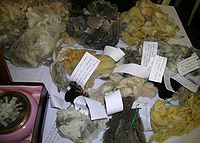
Merino wool is typically 3-5 inches in length and is very fine (between 12-24 microns
Micron (wool)
A micron is the measurement used to express the diameter of a wool fibre. The lower microns are the finer fibres. Fibre diameter is the most important characteristic of wool in determining its greasy value....
). The finest and most valuable wool comes from Merino
Merino
The Merino is an economically influential breed of sheep prized for its wool. Merinos are regarded as having some of the finest and softest wool of any sheep...
hoggets. Wool taken from sheep produced for meat is typically more coarse, and has fibers that are 1.5 to 6 in (38.1 to 152.4 mm) in length. Damage or breaks in the wool can occur if the sheep is stressed while it is growing its fleece, resulting in a thin spot where the fleece is likely to break.
Wool is also separated into grades based on the measurement of the wool's diameter in microns and also its style. These grades may vary depending on the breed or purpose of the wool. For example:
- <15.5 - Ultrafine Merino
- 15.6-18.5 - Superfine Merino
- 18.6-20 - Fine Merino
- 20.1-23 - Medium Merino
- 23< - Strong Merino
- ComebackComeback (sheep)The Comeback is a type of domestic sheep originating in Australia. This type of sheep results from crossbreds produced by British Longwool sheep and a Merinos being mated back to Merinos. This cross is made in order to achieve a finer, better style of wool. Comeback style wool is also produced by...
: 21-26 microns, white, 90–180 mm long - Fine crossbred: 27-31 microns, Corriedales, etc.
- Medium crossbred: 32–35 microns
- Downs: 23-34 microns, typically lacks luster and brightness. Examples, AussiedownAussiedown (sheep)Aussiedown sheep are an Australian breed of sheep that was developed in the early 1990s using Southdown and Texel genetics. The resulting progeny have a maximum of 75% Southdown and Texel ancestry...
, Dorset HornDorset (sheep)The Dorset or Dorset Horned breed of sheep is known mostly for its prolific lambing. It has been known to produce two lambing seasons per year: bred in May for lambs finished by the holidays, and bred again immediately after the first lambing to produce again in March or April...
, SuffolkSuffolk (sheep)Suffolk are a black-faced, open-faced breed of domestic sheep raised primarily for meat.-Ewes:They are mainly raised for wool and meat production especially when crossed with the progeny of a mountain ewe. For example, a purebred upland ewe such as a Welsh Mountain ewe might be bred with a breeding...
, etc. - Coarse crossbred: 36> microns
- Carpet wools: 35-45 microns
Any wool finer than 25 microns can be used for garments, while coarser grades are used for outerwear or rugs. The finer the wool, the softer it is, while coarser grades are more durable and less prone to pilling
Pill (textile)
A pill, colloquially known as a bobble, is a small ball of fibres that forms on a piece of cloth from wear. Pill is also a verb for the formation of such balls....
.
The finest Australia
Australia
Australia , officially the Commonwealth of Australia, is a country in the Southern Hemisphere comprising the mainland of the Australian continent, the island of Tasmania, and numerous smaller islands in the Indian and Pacific Oceans. It is the world's sixth-largest country by total area...
n and New Zealand
New Zealand
New Zealand is an island country in the south-western Pacific Ocean comprising two main landmasses and numerous smaller islands. The country is situated some east of Australia across the Tasman Sea, and roughly south of the Pacific island nations of New Caledonia, Fiji, and Tonga...
Merino wools are known as 1PP which is the industry benchmark of excellence for Merino wool that is 16.9 micron and finer. This style represents the top level of fineness, character, color, and style as determined on the basis of a series of parameters in accordance with the original dictates of British Wool as applied today by the Australian Wool Exchange (AWEX) Council. Only a few dozen of the millions of bales auctioned every year can be classified and marked 1PP.
History
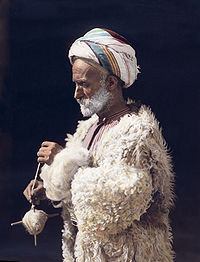

Textile
A textile or cloth is a flexible woven material consisting of a network of natural or artificial fibres often referred to as thread or yarn. Yarn is produced by spinning raw fibres of wool, flax, cotton, or other material to produce long strands...
, ca. 1500 BC, was preserved in a Danish bog.
Prior to invention of shears - probably in the Iron Age
Iron Age
The Iron Age is the archaeological period generally occurring after the Bronze Age, marked by the prevalent use of iron. The early period of the age is characterized by the widespread use of iron or steel. The adoption of such material coincided with other changes in society, including differing...
- the wool was plucked out by hand or by bronze combs. In Roman times, wool, linen
Linen
Linen is a textile made from the fibers of the flax plant, Linum usitatissimum. Linen is labor-intensive to manufacture, but when it is made into garments, it is valued for its exceptional coolness and freshness in hot weather....
, and leather
Leather
Leather is a durable and flexible material created via the tanning of putrescible animal rawhide and skin, primarily cattlehide. It can be produced through different manufacturing processes, ranging from cottage industry to heavy industry.-Forms:...
clothed the European population; the cotton
Cotton
Cotton is a soft, fluffy staple fiber that grows in a boll, or protective capsule, around the seeds of cotton plants of the genus Gossypium. The fiber is almost pure cellulose. The botanical purpose of cotton fiber is to aid in seed dispersal....
of India was a curiosity that only naturalists had heard of; and silk
Silk
Silk is a natural protein fiber, some forms of which can be woven into textiles. The best-known type of silk is obtained from the cocoons of the larvae of the mulberry silkworm Bombyx mori reared in captivity...
, imported along the Silk Road
Silk Road
The Silk Road or Silk Route refers to a historical network of interlinking trade routes across the Afro-Eurasian landmass that connected East, South, and Western Asia with the Mediterranean and European world, as well as parts of North and East Africa...
from China, was an extravagant luxury. Pliny the Elder
Pliny the Elder
Gaius Plinius Secundus , better known as Pliny the Elder, was a Roman author, naturalist, and natural philosopher, as well as naval and army commander of the early Roman Empire, and personal friend of the emperor Vespasian...
records in his Natural History that the reputation for producing the finest wool was enjoyed by Tarentum
Taranto
Taranto is a coastal city in Apulia, Southern Italy. It is the capital of the Province of Taranto and is an important commercial port as well as the main Italian naval base....
, where selective breeding had produced sheep with a superior fleece, but which required special care.
In medieval times, as trade connections expanded, the Champagne fairs
Champagne fairs
The Champagne fairs were an annual cycle of trading fairs held in towns in the Champagne and Brie regions of France in the Middle Ages. From their origins in local agricultural and stock fairs, the Champagne fairs became an important engine in the reviving economic history of medieval Europe,...
revolved around the production of wool cloth in small centers such as Provins
Provins
Provins is a commune in the Seine-et-Marne department in the Île-de-France region in north-central France.Provins, a town of medieval fairs, became a UNESCOWorld Heritage Site in 2001.-Administration:...
; the network that the sequence of annual fairs developed meant that the woollens of Provins might find their way to Naples, Sicily, Cyprus, Majorca, Spain, and even Constantinople. The wool trade developed into serious business, the generator of capital. In the thirteenth century, the wool trade was the economic engine of the Low Countries
Low Countries
The Low Countries are the historical lands around the low-lying delta of the Rhine, Scheldt, and Meuse rivers, including the modern countries of Belgium, the Netherlands, Luxembourg and parts of northern France and western Germany....
and of Central Italy; by the end of the following century Italy predominated, though in the 16th century Italian production turned to silk. Both pre-industries were based on English raw wool exports - rivaled only by the sheepwalk
Sheepwalk
A sheepwalk is an area of grassland where sheep can roam freely.The productivity of sheepwalk is measured by the number of sheep per area. This is dependent, among other things, on the underlying rock....
s of Castile
Castile (historical region)
A former kingdom, Castile gradually merged with its neighbours to become the Crown of Castile and later the Kingdom of Spain when united with the Crown of Aragon and the Kingdom of Navarre...
, developed from the fifteenth century - which were a significant source of income to the English crown, which from 1275 imposed an export tax on wool called the "Great Custom". The importance of wool to the English economy can be shown by the fact that since the 14th Century, the presiding officer of the House of Lords
House of Lords
The House of Lords is the upper house of the Parliament of the United Kingdom. Like the House of Commons, it meets in the Palace of Westminster....
has sat on the "Woolsack
Woolsack
The Woolsack is the seat of the Lord Speaker in the House of Lords, the Upper House of the Parliament of the United Kingdom. From the Middle Ages until 2006, the presiding officer in the House of Lords was the Lord Chancellor and the Woolsack was usually mentioned in association with the office of...
", a chair stuffed with wool.
Economies of scale were instituted in the Cistercian houses, which had accumulated great tracts of land during the twelfth and early thirteenth centuries, when land prices were low and labor still scarce. Raw wool was baled and shipped from North Sea ports to the textile cities of Flanders
Flanders
Flanders is the community of the Flemings but also one of the institutions in Belgium, and a geographical region located in parts of present-day Belgium, France and the Netherlands. "Flanders" can also refer to the northern part of Belgium that contains Brussels, Bruges, Ghent and Antwerp...
, notably Ypres
Ypres
Ypres is a Belgian municipality located in the Flemish province of West Flanders. The municipality comprises the city of Ypres and the villages of Boezinge, Brielen, Dikkebus, Elverdinge, Hollebeke, Sint-Jan, Vlamertinge, Voormezele, Zillebeke, and Zuidschote...
and Ghent
Ghent
Ghent is a city and a municipality located in the Flemish region of Belgium. It is the capital and biggest city of the East Flanders province. The city started as a settlement at the confluence of the Rivers Scheldt and Lys and in the Middle Ages became one of the largest and richest cities of...
, where it was dyed and worked up as cloth. At the time of the Black Death, English textile industries accounted for about 10% of English wool production; the English textile trade grew during the fifteenth century, to the point where export of wool was discouraged. Over the centuries, various British laws controlled the wool trade or required the use of wool even in burials. The smuggling of wool out of the country, known as owling, was at one time punishable by the cutting off of a hand. After the Restoration, fine English woollens began to compete with silks in the international market, partly aided by the Navigation Acts
Navigation Acts
The English Navigation Acts were a series of laws that restricted the use of foreign shipping for trade between England and its colonies, a process which had started in 1651. Their goal was to force colonial development into lines favorable to England, and stop direct colonial trade with the...
; in 1699 English crown forbade its American colonies to trade wool with anyone but England herself.
A great deal of the value of woollen textiles was in the dyeing
Dyeing
Dyeing is the process of adding color to textile products like fibers, yarns, and fabrics. Dyeing is normally done in a special solution containing dyes and particular chemical material. After dyeing, dye molecules have uncut Chemical bond with fiber molecules. The temperature and time controlling...
and finishing
Finishing (textiles)
In textile manufacturing, finishing refers to any process performed on yarn or fabric after weaving or knitting to improve the look, performance, or "hand" of the finished textile or clothing...
of the woven product. In each of the centers of the textile trade, the manufacturing process came to be subdivided into a collection of trades, overseen by an entrepreneur in a system called by the English the "putting-out" system, or "cottage industry", and the Verlagssystem by the Germans. In this system of producing wool cloth, until recently perpetuated in the production of Harris tweed
Harris Tweed
Harris Tweed is a cloth that has been handwoven by the islanders on the Isles of Harris, Lewis, Uist and Barra in the Outer Hebrides of Scotland, using local wool....
s, the entrepreneur provides the raw materials and an advance, the remainder being paid upon delivery of the product. Written contracts bound the artisans to specified terms. Fernand Braudel
Fernand Braudel
Fernand Braudel was a French historian and a leader of the Annales School. His scholarship focused on three main projects, each representing several decades of intense study: The Mediterranean , Civilization and Capitalism , and the unfinished Identity of France...
traces the appearance of the system in the thirteenth-century economic boom, quoting a document of 1275 The system effectively by-passed the guilds' restrictions.
Before the flowering of the Renaissance, the Medici
Medici
The House of Medici or Famiglia de' Medici was a political dynasty, banking family and later royal house that first began to gather prominence under Cosimo de' Medici in the Republic of Florence during the late 14th century. The family originated in the Mugello region of the Tuscan countryside,...
and other great banking houses of Florence had built their wealth and banking system on their textile industry based on wool, overseen by the Arte della Lana
Arte della Lana
The Arte della Lana was the wool guild of Florence during the Late Middle Ages and in the Renaissance. It was one of the seven greater Arti of Florence, separate from the Arti Minori...
, the wool guild: wool textile interests guided Florentine policies. Francesco Datini, the "merchant of Prato", established in 1383 an Arte della Lana for that small Tuscan city. The sheepwalks of Castile
Castile (historical region)
A former kingdom, Castile gradually merged with its neighbours to become the Crown of Castile and later the Kingdom of Spain when united with the Crown of Aragon and the Kingdom of Navarre...
shaped the landscape and the fortunes of the meseta that lies in the heart of the Iberian peninsula; in the sixteenth century, a unified Spain allowed export of Merino
Merino
The Merino is an economically influential breed of sheep prized for its wool. Merinos are regarded as having some of the finest and softest wool of any sheep...
lambs only with royal permission. The German wool market - based on sheep of Spanish origin - did not overtake British wool until comparatively late. The Industrial Revolution
Industrial Revolution
The Industrial Revolution was a period from the 18th to the 19th century where major changes in agriculture, manufacturing, mining, transportation, and technology had a profound effect on the social, economic and cultural conditions of the times...
introduced mass production technology into wool and wool cloth manufacturing. Australia's colonial economy was based on sheep raising, and the Australian wool trade eventually overtook that of the Germans by 1845, furnishing wool for Bradford
Bradford
Bradford lies at the heart of the City of Bradford, a metropolitan borough of West Yorkshire, in Northern England. It is situated in the foothills of the Pennines, west of Leeds, and northwest of Wakefield. Bradford became a municipal borough in 1847, and received its charter as a city in 1897...
, which developed as the heart of industrialized woollens production.
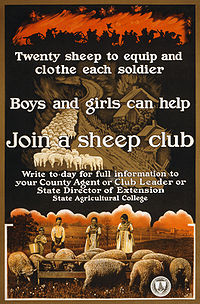
Superwash wool (or washable wool) technology first appeared in the early 1970s to produce wool that has been specially treated so that it is machine washable and may be tumble-dried. This wool is produced using an acid bath that removes the "scales" from the fiber, or by coating the fiber with a polymer that prevents the scales from attaching to each other and causing shrinkage. This process results in a fiber that holds longevity and durability over synthetic materials, while retaining its shape.
In December 2004, a bale of the world's finest wool, averaging 11.8 micron, sold for $3,000 per kilogram at auction in Melbourne
Melbourne
Melbourne is the capital and most populous city in the state of Victoria, and the second most populous city in Australia. The Melbourne City Centre is the hub of the greater metropolitan area and the Census statistical division—of which "Melbourne" is the common name. As of June 2009, the greater...
, Victoria. This fleece wool tested with an average yield of 74.5%, 68 mm long, and had 40 newtons per kilotex strength. The result was $AUD279,000 for the bale.
The finest bale of wool ever auction
Auction
An auction is a process of buying and selling goods or services by offering them up for bid, taking bids, and then selling the item to the highest bidder...
ed sold for a seasonal record of 269,000 cents per kilo during June 2008. This bale was produced by the Hillcreston Pinehill Partnership and measured 11.6 microns, 72.1% yield and had a 43 Newtons per kilotex strength measurement. The bale realized $247,480 and was exported to India
India
India , officially the Republic of India , is a country in South Asia. It is the seventh-largest country by geographical area, the second-most populous country with over 1.2 billion people, and the most populous democracy in the world...
.
During 2007 a new wool suit was developed and sold in Japan that can be washed in the shower, and dries off ready to wear within hours with no ironing required. The suit was developed using Australian Merino wool and it enables woven products made from wool, such as suits, trousers and skirts, to be cleaned using a domestic shower at home.
In December 2006 the General Assembly of the United Nations proclaimed 2009 to be the International Year of Natural Fibres
International Year of Natural Fibres
The United Nations General Assembly declared 2009 as the International Year of Natural Fibres, as well as the International Year of Astronomy.The proposal for this international year originated in FAO at a joint meeting of the Intergovernmental Group on Hard Fibres and the Intergovernmental Group...
, so to raise the profile of wool and other natural fiber
Natural fiber
Fibers or fibres are a class of hair-like materials that are continuous filaments or are in discrete elongated pieces, similar to pieces of thread. They can be spun into filaments, thread, or rope. They can be used as a component of composite materials. They can also be matted into sheets to...
s.
Production
Global wool production is approximately 1.3 million tonnes per year, of which 60% goes into apparel. AustraliaAustralia
Australia , officially the Commonwealth of Australia, is a country in the Southern Hemisphere comprising the mainland of the Australian continent, the island of Tasmania, and numerous smaller islands in the Indian and Pacific Oceans. It is the world's sixth-largest country by total area...
is the leading producer of wool which is mostly from Merino
Merino
The Merino is an economically influential breed of sheep prized for its wool. Merinos are regarded as having some of the finest and softest wool of any sheep...
sheep. New Zealand
New Zealand
New Zealand is an island country in the south-western Pacific Ocean comprising two main landmasses and numerous smaller islands. The country is situated some east of Australia across the Tasman Sea, and roughly south of the Pacific island nations of New Caledonia, Fiji, and Tonga...
is the second-largest producer of wool, and the largest producer of crossbred wool. China
China
Chinese civilization may refer to:* China for more general discussion of the country.* Chinese culture* Greater China, the transnational community of ethnic Chinese.* History of China* Sinosphere, the area historically affected by Chinese culture...
is the third-largest producer of wool. Breeds such as Lincoln
Lincoln (sheep)
The Lincoln, sometimes called the Lincoln Longwool, is a breed of sheep from England. The Lincoln is the largest British sheep, developed specifically to produce the heaviest, longest and most lustrous fleece of any breed in the world. Great numbers were exported to many countries to improve the...
, Romney
Romney (sheep)
The Romney, formerly called the Romney Marsh sheep but generally referred-to by the local farmers as the Kent, is a breed of sheep originating in England. The Romney is a "long-wool" breed recognized in England by 1800...
, Tukidale, Drysdale and Elliotdale produce coarser fibers, and wool from these sheep is usually used for making carpet
Carpet
A carpet is a textile floor covering consisting of an upper layer of "pile" attached to a backing. The pile is generally either made from wool or a manmade fibre such as polypropylene,nylon or polyester and usually consists of twisted tufts which are often heat-treated to maintain their...
s.
In the United States, Texas
Texas
Texas is the second largest U.S. state by both area and population, and the largest state by area in the contiguous United States.The name, based on the Caddo word "Tejas" meaning "friends" or "allies", was applied by the Spanish to the Caddo themselves and to the region of their settlement in...
, New Mexico
New Mexico
New Mexico is a state located in the southwest and western regions of the United States. New Mexico is also usually considered one of the Mountain States. With a population density of 16 per square mile, New Mexico is the sixth-most sparsely inhabited U.S...
and Colorado
Colorado
Colorado is a U.S. state that encompasses much of the Rocky Mountains as well as the northeastern portion of the Colorado Plateau and the western edge of the Great Plains...
have large commercial sheep flocks and their mainstay is the Rambouillet
Rambouillet (sheep)
The Rambouillet is also known as the Rambouillet Merino or the French Merino. The development of the Rambouillet breed started in 1786 when Louis XVI purchased over three hundred Spanish Merinos from his cousin, King Charles III of Spain...
(or French Merino). There is also a thriving home-flock contingent of small-scale farmers who raise small hobby flocks of specialty sheep for the hand spinning market. These small-scale farmers offer a wide selection of fleece.
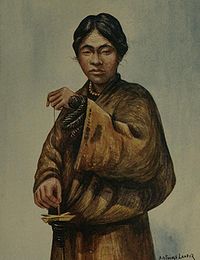
 Australia: 25% of global woolclip (475 million kg greasy, 2004/2005)
Australia: 25% of global woolclip (475 million kg greasy, 2004/2005) Mainland China: 18%
Mainland China: 18% New Zealand: 11%
New Zealand: 11% Argentina: 3%
Argentina: 3% Turkey: 2%
Turkey: 2% Iran: 2%
Iran: 2% United Kingdom: 2%
United Kingdom: 2% India: 2%
India: 2% Sudan: 2%
Sudan: 2% South Africa: 1%
South Africa: 1% United States: 0.77%
United States: 0.77%
Organic wool is becoming more and more popular. This wool is very limited in supply and much of it comes from New Zealand and Australia. It is becoming easier to find in clothing and other products, but these products often carry a higher price. Wool is environmentally preferable (as compared to petroleum-based Nylon
Nylon
Nylon is a generic designation for a family of synthetic polymers known generically as polyamides, first produced on February 28, 1935, by Wallace Carothers at DuPont's research facility at the DuPont Experimental Station...
or Polypropylene
Polypropylene
Polypropylene , also known as polypropene, is a thermoplastic polymer used in a wide variety of applications including packaging, textiles , stationery, plastic parts and reusable containers of various types, laboratory equipment, loudspeakers, automotive components, and polymer banknotes...
) as a material for carpets as well, in particular when combined with a natural binding and the use of formaldehyde
Formaldehyde
Formaldehyde is an organic compound with the formula CH2O. It is the simplest aldehyde, hence its systematic name methanal.Formaldehyde is a colorless gas with a characteristic pungent odor. It is an important precursor to many other chemical compounds, especially for polymers...
-free glues.
Animal rights
Animal rights
Animal rights, also known as animal liberation, is the idea that the most basic interests of non-human animals should be afforded the same consideration as the similar interests of human beings...
groups have noted issues with the production of wool, such as Mulesing
Mulesing
Mulesing is a skilled surgical task that involves the removal of strips of wool-bearing skin from around the breech of a sheep to prevent flystrike in regions where it is common....
.
Australia
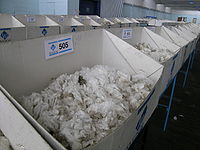

Auction
An auction is a process of buying and selling goods or services by offering them up for bid, taking bids, and then selling the item to the highest bidder...
. Sale by Sample is a method in which a mechanical claw takes a sample from each bale in a line or lot of wool. These grab samples are bulked, objectively measured, and a sample of not less than 4 kg is displayed in a box for the buyer to examine. The Australian Wool Exchange (AWEX) conducts sales primarily in Sydney
Sydney
Sydney is the most populous city in Australia and the state capital of New South Wales. Sydney is located on Australia's south-east coast of the Tasman Sea. As of June 2010, the greater metropolitan area had an approximate population of 4.6 million people...
, Melbourne
Melbourne
Melbourne is the capital and most populous city in the state of Victoria, and the second most populous city in Australia. The Melbourne City Centre is the hub of the greater metropolitan area and the Census statistical division—of which "Melbourne" is the common name. As of June 2009, the greater...
, Newcastle
Newcastle, New South Wales
The Newcastle metropolitan area is the second most populated area in the Australian state of New South Wales and includes most of the Newcastle and Lake Macquarie Local Government Areas...
, and Fremantle
Fremantle
Freemantle is a suburb of Southampton in England.Fremantle or Freemantle may also refer to:- Places :* Fremantle, the port city to the capital Perth, Western Australia...
. There are about 80 brokers and agents throughout Australia.
About 7% of Australian wool is sold by private treaty on farms or to local wool-handling facilities. This option gives wool growers benefit from reduced transport, warehousing, and selling costs. This method is preferred for small lots or mixed butts in order to make savings on reclassing and testing.
About 5% of Australian wool is sold over the internet on an electronic offer board. This option gives wool growers the ability to set firm price targets, reoffer passed in wool and offer lots to the market quickly and efficiently. This method works well for tested lots as buyers use these results to make a purchase. 97% of wool is sold without sample inspection; however, as of Dec 2009, 59% of wool listed had been passed in from auction. Growers through certain brokers can allocate their wool to a sale and what price their wool will be reserved at.
Sale by tender can achieve considerable cost savings on wool clips large enough to make it worthwhile for potential buyers to submit tenders. Some marketing firms sell wool on a consignment basis, obtaining a fixed percentage as commission.
Forward selling: Some buyers offer a secure price for forward delivery of wool based on estimated measurements or the results of previous clips. Prices are quoted at current market rates and are locked in for the season. Premiums and discounts are added to cover variations in micron, yield, tensile strength, etc., which are confirmed by actual test results when available.
Another method of selling wool includes sales direct to wool mills.
Other countries
The British Wool Marketing Board operates a central marketing system for UK fleece wool with the aim of achieving the best possible net returns for farmers.Less than half of New Zealand
New Zealand
New Zealand is an island country in the south-western Pacific Ocean comprising two main landmasses and numerous smaller islands. The country is situated some east of Australia across the Tasman Sea, and roughly south of the Pacific island nations of New Caledonia, Fiji, and Tonga...
's wool is sold at auction, while around 45% for farmers sell wool directly to private buyers and end-users. Some businesses in New Zealand like Blue House Yarns have turned to selling organic wool
Organic wool
-Defining organic wool:Organic wool yarn is wool that is from sheep that have not been exposed to chemicals like pesticides and are kept in humane and good farm conditions...
, a new trend on wool production.
United States
United States
The United States of America is a federal constitutional republic comprising fifty states and a federal district...
sheep producers market wool with private or cooperative wool warehouses, but wool pools are common in many states. In some cases, wool is pooled in a local market area but sold through a wool warehouse. Wool offered with objective measurement test results is preferred. Imported apparel wool and carpet wool goes directly to central markets, where it is handled by the large merchants and manufacturers.
Uses
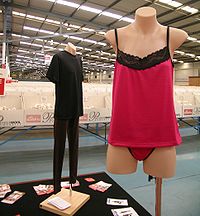
Clothing
Clothing refers to any covering for the human body that is worn. The wearing of clothing is exclusively a human characteristic and is a feature of nearly all human societies...
, wool has been used for blankets, horse rugs, saddle cloths, carpet
Carpet
A carpet is a textile floor covering consisting of an upper layer of "pile" attached to a backing. The pile is generally either made from wool or a manmade fibre such as polypropylene,nylon or polyester and usually consists of twisted tufts which are often heat-treated to maintain their...
ing, felt
Felt
Felt is a non-woven cloth that is produced by matting, condensing and pressing woollen fibres. While some types of felt are very soft, some are tough enough to form construction materials. Felt can be of any colour, and made into any shape or size....
, wool insulation
Wool insulation
Wool insulation is made solely from sheep wool fibres that are either mechanically held together or bonded using up to 12% polyester adhesive to form insulating batts, rolls and ropes. Batts are commonly used in timber-frame buildings, rolls for lofts and ropes are primarily used between the logs...
(also see links) and upholstery. Wool felt covers piano hammers, and it is used to absorb odors and noise in heavy machinery and stereo speakers. Ancient Greeks lined their helmets with felt, and Roman legionnaires used breastplates made of wool felt.
Wool has also been traditionally used to cover cloth diapers. Wool fiber exteriors are hydrophobic (repel water) and the interior of the wool fiber is hygroscopic (attracts water); this makes a wool garment able to cover a wet diaper while inhibiting wicking, so outer garments remain dry. Wool felted and treated with lanolin
Lanolin
Lanolin , also called Adeps Lanae, wool wax or wool grease, is a yellow waxy substance secreted by the sebaceous glands of wool-bearing animals. Most lanolin used by humans comes from domestic sheep...
is water resistant, air permeable, and slightly antibacterial, so it resists the buildup of odor. Some modern cloth diapers use felted wool fabric for covers, and there are several modern commercial knitting
Knitting
Knitting is a method by which thread or yarn may be turned into cloth or other fine crafts. Knitted fabric consists of consecutive rows of loops, called stitches. As each row progresses, a new loop is pulled through an existing loop. The active stitches are held on a needle until another loop can...
patterns for wool diaper covers.
Initial studies of woollen underwear have found it prevented heat and sweat rashes because it more readily absorbs the moisture than other fibers.
Merino wool has been used in baby sleep products such as swaddle baby wrap blankets and infant sleeping bags.
Wool is an animal protein, and as such it can be used as a soil fertiliser, being a slow release source of nitrogen and ready made amino acids.
Researchers at the Royal Melbourne Institute of Technology school of fashion and textiles have discovered that a blend of wool and kevlar, the synthetic fiber widely used in body armor, was lighter and cheaper and worked better in damp conditions than kevlar alone. Kevlar, when used alone loses about 20 per cent of its effectiveness when wet and therefore required an expensive waterproofing process. Wool increased friction in a vest with 28-30 layers of fabric, to provide the same level of bullet resistance as 36 layers of Kevlar alone.
Yarns
Virgin wool is wool spun for the first time.Shoddy or recycled wool is made by cutting or tearing apart existing wool fabric and respinning the resulting fibers. As this process makes the wool fibers shorter, the remanufactured fabric is inferior to the original. The recycled wool may be mixed with raw wool, wool noil
Noil
Noil is the short fiber left over from combing wool or spinning silk and used as a decorative additive for many spinning projects, like rovings and yarns. Silk noil is also called "raw silk", although that is a misnomer. As noil is a relatively short fiber, fabric made from noil is weaker and...
, or another fiber such as cotton
Cotton
Cotton is a soft, fluffy staple fiber that grows in a boll, or protective capsule, around the seeds of cotton plants of the genus Gossypium. The fiber is almost pure cellulose. The botanical purpose of cotton fiber is to aid in seed dispersal....
to increase the average fiber length. Such yarn
Yarn
Yarn is a long continuous length of interlocked fibres, suitable for use in the production of textiles, sewing, crocheting, knitting, weaving, embroidery and ropemaking. Thread is a type of yarn intended for sewing by hand or machine. Modern manufactured sewing threads may be finished with wax or...
s are typically used as weft
Weft
In weaving, weft or woof is the yarn which is drawn through the warp yarns to create cloth. In North America, it is sometimes referred to as the "fill" or the "filling yarn"....
yarns with a cotton warp
Warp (weaving)
In weaving cloth, the warp is the set of lengthwise yarns that are held in tension on a frame or loom. The yarn that is inserted over-and-under the warp threads is called the weft, woof, or filler. Each individual warp thread in a fabric is called a warp end or end. Warp means "that which is thrown...
. This process was invented in the Heavy Woollen District
Heavy Woollen District
The Heavy Woollen District is named because of the heavyweight cloth manufactured in an area of West Yorkshire, England. Dewsbury, Batley, Heckmondwike and Ossett are the core of the area. Liversedge, Gomersal, Gildersome, Birkenshaw, Mirfield, Cleckheaton, Morley, Tingley, East Ardsley, Birstall...
of West Yorkshire
West Yorkshire
West Yorkshire is a metropolitan county within the Yorkshire and the Humber region of England with a population of 2.2 million. West Yorkshire came into existence as a metropolitan county in 1974 after the passage of the Local Government Act 1972....
and created a micro-economy in this area for many years.
Ragg is a sturdy wool fiber made into yarn and used in many rugged applications like gloves.
Worsted
Worsted
Worsted , is the name of a yarn, the cloth made from this yarn, and a yarn weight category. The name derives from the village of Worstead in the English county of Norfolk...
is a strong, long-staple, combed
Combing
Combing is a method for preparing carded fibre for spinning. It separates out the short fibres by means of a rotating ring of steel pins. The fibres in the 'top' it produces, have been straightened and lie parallel to each other...
wool yarn with a hard surface.
Woollen is a soft, short-staple, carded
Carding
Carding is a mechanical process that breaks up locks and unorganised clumps of fibre and then aligns the individual fibres so that they are more or less parallel with each other. The word is derived from the Latin carduus meaning teasel, as dried vegetable teasels were first used to comb the raw wool...
wool yarn typically used for knitting. In traditional weaving, woollen weft yarn (for softness and warmth) is frequently combined with a worsted warp yarn for strength on the loom.
Events
A buyer of MerinoMerino
The Merino is an economically influential breed of sheep prized for its wool. Merinos are regarded as having some of the finest and softest wool of any sheep...
wool, Ermenegildo Zegna
Ermenegildo Zegna
Ermenegildo Zegna is a leading Italian fashion house, specialing in men's clothing. Founded in 1910, it is now managed by the fourth generation of the Zegna family and remains in family ownership. As well as producing suits for its own labels, it manufactures suits for labels such as Gucci, Yves...
, has offered awards for Australian wool producers. In 1963, the first Ermenegildo Zegna Perpetual Trophy was presented in Tasmania for growers of "Superfine skirted Merino fleece". In 1980, a national award, the Ermenegildo Zegna Trophy for Extrafine Wool Production, was launched. In 2004, this award became known as the Ermenegildo Zegna Unprotected Wool Trophy. In 1998, an Ermenegildo Zegna Protected Wool Trophy was launched for fleece from sheep coated for around nine months of the year.
In 2002, the Ermenegildo Zegna Vellus Aureum Trophy was launched for wool that is 13.9 micron and finer. Wool from Australia, New Zealand
New Zealand
New Zealand is an island country in the south-western Pacific Ocean comprising two main landmasses and numerous smaller islands. The country is situated some east of Australia across the Tasman Sea, and roughly south of the Pacific island nations of New Caledonia, Fiji, and Tonga...
, Argentina
Argentina
Argentina , officially the Argentine Republic , is the second largest country in South America by land area, after Brazil. It is constituted as a federation of 23 provinces and an autonomous city, Buenos Aires...
, and South Africa
South Africa
The Republic of South Africa is a country in southern Africa. Located at the southern tip of Africa, it is divided into nine provinces, with of coastline on the Atlantic and Indian oceans...
may enter, and a winner is named from each country. In April 2008, New Zealand won the Ermenegildo Zegna Vellus Aureum Trophy for the first time with a fleece that measured 10.8 microns. This contest awards the winning fleece weight with the same weight in gold as a prize, hence the name.
In 2010 an ultra-fine, 10 micron fleece, from Windradeen, near Pyramul, New South Wales
New South Wales
New South Wales is a state of :Australia, located in the east of the country. It is bordered by Queensland, Victoria and South Australia to the north, south and west respectively. To the east, the state is bordered by the Tasman Sea, which forms part of the Pacific Ocean. New South Wales...
set a new world record in the fineness of wool fleeces when it won the Ermenegildo Zegna Vellus Aureum International Trophy.
Since 2000, Loro Piana
Loro Piana
Loro Piana is an Italian clothing company specialising in high-end, luxury cashmere and wool products.-History:Originally from Trivero , the Loro Piana family started as merchants of wool fabrics at the beginning of the nineteenth century...
has awarded a cup for the world’s finest bale of wool that produces just enough fabric for 50 tailor-made suits. The prize is awarded to an Australian or New Zealand wool grower who produces the year's finest bale.
The New England
New England (Australia)
New England or New England North West is the name given to a generally undefined region about 60 kilometres inland, that includes the Northern Tablelands and the North West Slopes regions in the north of the state of New South Wales, Australia.-History:The region has been occupied by Indigenous...
Merino Field days which display local studs, wool, and sheep are held during January, every two years (in even numbered years) around the Walcha, New South Wales
Walcha, New South Wales
Walcha is a parish and town at the south-eastern edge of the Northern Tablelands, New South Wales, Australia.The town serves as the seat of Walcha Shire. Walcha is located 425 kilometres by road from Sydney at the intersection of the Oxley Highway and Thunderbolts Way...
district. The Annual Wool Fashion Awards, which showcase the use of Merino wool by fashion designers, are hosted by the city of Armidale, New South Wales
Armidale, New South Wales
Armidale is a city in the Northern Tablelands, New South Wales, Australia. Armidale Dumaresq Shire had a population of 19,485 people according to the 2006 census. It is the administrative centre for the Northern Tablelands region...
in March each year. This event encourages young and established fashion designers to display their talents. During each May, Armidale hosts the annual New England Wool Expo to display wool fashions, handicrafts, demonstrations, shearing competitions, yard dog trials, and more.
In July, the annual Australian Sheep and Wool Show is held in Bendigo, Victoria
Bendigo, Victoria
Bendigo is a major regional city in the state of Victoria, Australia, located very close to the geographical centre of the state and approximately north west of the state capital Melbourne. It is the second largest inland city and fourth most populous city in the state. The estimated urban...
. This is the largest sheep and wool show in the world, with goats and alpacas as well as woolcraft competitions and displays, fleece competitions, sheepdog trials, shearing, and wool handling. The largest competition in the world for objectively-measured fleeces is the Australian Fleece Competition, which is held annually at Bendigo. In 2008, there were 475 entries from all states of Australia with first and second prizes going to the Northern Tablelands, New South Wales
Northern Tablelands, New South Wales
The Northern Tablelands, also known as the New England Tableland, is a plateau and a region of the Great Dividing Range in northern New South Wales, Australia. It includes the New England Range, the narrow highlands area of the New England region, stretching from the Moonbi Range in the south to...
fleeces.
Production
- Glossary of sheep husbandryGlossary of sheep husbandryThe raising of domestic sheep has occurred in nearly every inhabited part of the globe, and the variations in cultures and languages which have kept sheep has produced a vast lexicon of unique terminology used to describe sheep husbandry...
- LambswoolLambswoolLambswool is wool which is 50mm or shorter from the first shearing of a sheep, at around the age of seven months. It is soft, elastic, and slippery, and is used in high-grade textiles....
- Merino (sheep)
- Micron (wool)Micron (wool)A micron is the measurement used to express the diameter of a wool fibre. The lower microns are the finer fibres. Fibre diameter is the most important characteristic of wool in determining its greasy value....
- Sheep husbandrySheep husbandrySheep husbandry is a subcategory of animal husbandry specifically dealing with the raising and breeding of domestic sheep. Sheep farming is primarily based on raising lambs for meat, or raising sheep for wool. Sheep may also be raised for milk or to sell to other farmers.-Shelter and...
- Sheep shearingSheep shearingSheep shearing, shearing or clipping is the process by which the woollen fleece of a sheep is cut off. The person who removes the sheep's wool is called a shearer. Typically each adult sheep is shorn once each year...
- Staple (wool)
- Wool baleWool baleA wool bale is a standard sized and weighted pack of classed wool compressed by the mechanical means of a wool press. This is the regulation required method of packaging for wool, to keep it uncontaminated and readily identifiable...
- Wool classingWool classingWool classing is an occupation for which people are trained to produce uniform, predictable, low risk lines of wool. This is carried out by examining the characteristics of the wool in its raw state. The characteristics which a wool classer would examine are:Breed of the sheep: Shedding breeds will...
Processing
- Canvas workCanvas workCanvas work is a type of embroidery in which yarn is stitched through a canvas or other foundation fabric. Canvas work is a form of counted-thread embroidery...
- CardingCardingCarding is a mechanical process that breaks up locks and unorganised clumps of fibre and then aligns the individual fibres so that they are more or less parallel with each other. The word is derived from the Latin carduus meaning teasel, as dried vegetable teasels were first used to comb the raw wool...
- CombingCombingCombing is a method for preparing carded fibre for spinning. It separates out the short fibres by means of a rotating ring of steel pins. The fibres in the 'top' it produces, have been straightened and lie parallel to each other...
- KnittingKnittingKnitting is a method by which thread or yarn may be turned into cloth or other fine crafts. Knitted fabric consists of consecutive rows of loops, called stitches. As each row progresses, a new loop is pulled through an existing loop. The active stitches are held on a needle until another loop can...
- SpinningSpinning (textiles)Spinning is a major industry. It is part of the textile manufacturing process where three types of fibre are converted into yarn, then fabric, then textiles. The textiles are then fabricated into clothes or other artifacts. There are three industrial processes available to spin yarn, and a...
- Textile manufacturingTextile manufacturingTextile manufacturing is a major industry. It is based in the conversion of three types of fibre into yarn, then fabric, then textiles. These are then fabricated into clothes or other artifacts. Cotton remains the most important natural fibre, so is treated in depth...
- Timeline of clothing and textiles technologyTimeline of clothing and textiles technologyTimeline of clothing and textiles technology.*Prehistory – spindle used to create yarn from fibres.* – loom.*c. 28000 BC – Sewing needles in use at Kostenki in Russia....
- WeavingWeavingWeaving is a method of fabric production in which two distinct sets of yarns or threads are interlaced at right angles to form a fabric or cloth. The other methods are knitting, lace making and felting. The longitudinal threads are called the warp and the lateral threads are the weft or filling...
- DyeingDyeingDyeing is the process of adding color to textile products like fibers, yarns, and fabrics. Dyeing is normally done in a special solution containing dyes and particular chemical material. After dyeing, dye molecules have uncut Chemical bond with fiber molecules. The temperature and time controlling...
Organizations
- British Wool Marketing BoardBritish Wool Marketing BoardThe British Wool Marketing Board operates the central marketing system for UK fleece wool. A farmer-run organisation, the BWMB was established in 1950 with the aim of achieving the best possible net return for producers. It is the only organisation in the world that collects, grades, sells and...
- Worshipful Company of WoolmenWorshipful Company of WoolmenThe Worshipful Company of Woolmen is one of the Livery Companies in the City of London. It is known to have existed in 1180, making it one of the older Livery Companies of the City. It was officially incorporated in 1522. The Company's original members were concerned with the winding and selling of...
- IWTOIWTOThe International Wool Textile Organisation is the international body representing the interests of the world's wool-textile trade and industry...
- The Natural Fibre CompanyThe Natural Fibre CompanyThe Natural Fibre Company is a British wool mill based in Launceston, Cornwall, and is the only small-scale full range textile mill in the UK....
(in the UK)
Miscellaneous wool
- Angora woolAngora woolAngora wool or Angora fibre refers to the downy coat produced by the Angora rabbit. While their names are similar, Angora fibre is distinct from mohair, which comes from the Angora goat. Angora is known for its softness, thin fibres, and what knitters refer to as a halo...
- Cashmere woolCashmere woolCashmere wool, usually simply known as cashmere, is a fiber obtained from Cashmere and other types of goats. The word cashmere derives from an old spelling of Kashmir. Cashmere is fine in texture, and strong, light, and soft. Garments made from it provide excellent...
- Chiengora woolChiengoraChiengora is a yarn or wool spun from dog hair. The word is a portmanteau of "chien", the French word for dog, and "angora." It is up to 80% warmer than wool and is not elastic....
- Llama wool
- MohairMohairMohair usually refers to a silk-like fabric or yarn made from the hair of the Angora goat. The word "mohair" was adopted into English before 1570 from the Arabic: mukhayyar, a type of haircloth, literally 'choice', from khayyara, 'he chose'. Mohair fiber is approximately 25-45 microns in...

